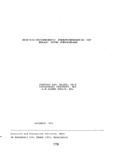Socio-economic performance of BRAC DTW program
Citation
Halder, S. R., Choudhury, S., & Husain, A. M. S. (1995, November). Socio-economic performance of BRAC DTW program. Research Reports (1995): Economic Studies, 378–415.Abstract
BRAC launched its irrigation program in early 1980s with low lift pump and then introduced the DTW program in 1984-85. Since 1990-91 BRAC has gone through a large-scale expansion of the program. In the last 1994-95 boro season 632 DTWs were operated in 89 RDP areas. The majority of these were not profitable during the season of operation. The cumulative loss of the BRAC DTW program up to 1995 was Tk. 53,716,151.
The present study tries to investigate the viability of DTW program to: 1) determine the profitability of the schemes; 2) investigate the program feasibility; and 3) investigate social impact of the schemes.
For the study seven RDP areas from seven regions were selected. A total of 22 schemes were taken as sample where every second scheme was non-profitable according to the 1993-94 program documentation. Schemes in operation for at least three years were selected and a total of 310 respondents were interviewed using open ended checklists. Respondents included: BRAC field staff, shareholders, dropout shareholders, farmers (user of DTW and non-user), elites and other respectable persons of the villages.
Quantitative data was taken from different program documents. Qualitative information was collected through interviews group discussions. To assess the social benefits RRA techniques were applied.
In 25 schemes of which 22 were in operation in the 1994-95 boro season only 9 were profitable in gross amount. The remaining 13 were not profitable on the basis of the actual revenue to be collected and the total cost of operation. Fourteen DTWs could be made profitable if total expected revenues were collected. The average command area of the schemes was 28.16 acres, only 60% of the target. Due to capacity loss in area coverage, averaging 18.8 acres per scheme, earnings from the actual command area covered only 95~ of total operational expenses. Because of shortfalls in collection, and high operational costs Tk. 89 per acre expected profit (if the collection was 100) turned to a loss of Tk. 91 per acre. These losses have been shifted indirectly as a subsidy to growers.
Major factors affecting demand-supply behavior for water were: 1) low area coverage; 2) high water intake of the sandy land; 3) kutcha drain; 4) diesel operated DTWs having less water lifting capacity; 5) installation of the DTW in the wrong location; 6) access of non BRAC DTWs/STWs within or nearby the command area; and 7) mismanagement in water supply.
The majority of shareholders in the schemes were female, which in the early stages of operation helped raise social status and create employment opportunities. These benefits could not be sustained, however, as systematic losses of the schemes made the shareholders inactive.
Share surrender was common among shareholders for a variety of reasons: dropout from VO membership, non-profitability and uncertainty of the schemes, share price increases, inability to pay more than one installment per week, misunderstanding among shareholders about leadership, conflict with the members of the DTW management and operation committee, and dissatisfaction of family members. Shareholders surrendering their shares did not get any compensation from BRAC for their paid installment and did not wait for getting back the amount.
Operation of BRAC DTW brought about a change in cropping patterns and increased paddy production. Increased cropping intensity and HYV boro cultivation created new employment opportunities in the lean season. But today cultivation of HYV boro is considered less cost-effective than cultivation of Robi crops like pulses, mustard, and wheat due to high prices of agricultural inputs.

